Addressing Childhood Obesity in Western Australia: A Program Plan
VerifiedAdded on 2023/01/06
|10
|2002
|2
Report
AI Summary
This report focuses on a public health program plan designed to address the escalating rates of obesity and overweight among indigenous children residing in regional areas of Western Australia. The report commences with a comprehensive needs assessment, highlighting the disproportionate impact of obesity on this demographic and its associated health risks. It then outlines a program overview, setting the strategic goal of preventing and improving obesity-related behaviors in children aged 0-10 from indigenous families and socio-economically disadvantaged backgrounds. The plan includes specific objectives, intervention strategies utilizing quasi-experimental designs and multi-strategy interventions, and a logic model illustrating the relationships between resources, activities, outputs, outcomes, and impact. The report emphasizes the need for a multifaceted approach, incorporating socio-cultural studies to inform interventions and policy actions aimed at reducing health disparities. The conclusion underscores the importance of implementing the proposed strategies to achieve the set objectives and goals within a defined timeframe, ultimately contributing to improved health outcomes for indigenous children in Western Australia.

Public Health Rationale and
Program Plan
Program Plan
Paraphrase This Document
Need a fresh take? Get an instant paraphrase of this document with our AI Paraphraser

Table of Contents
Topic: Curbing rise in obesity and overweight in Western Australia in indigenous children living
in regional areas...............................................................................................................................1
1) Assessing Needs..........................................................................................................................1
2) Program Overview and Setting the Goal.....................................................................................3
3) Objectives of Strategic Goals......................................................................................................4
4) Intervention Strategies.................................................................................................................4
5) Logic Model................................................................................................................................5
6) Conclusion of Plan.......................................................................................................................6
References........................................................................................................................................7
Topic: Curbing rise in obesity and overweight in Western Australia in indigenous children living
in regional areas...............................................................................................................................1
1) Assessing Needs..........................................................................................................................1
2) Program Overview and Setting the Goal.....................................................................................3
3) Objectives of Strategic Goals......................................................................................................4
4) Intervention Strategies.................................................................................................................4
5) Logic Model................................................................................................................................5
6) Conclusion of Plan.......................................................................................................................6
References........................................................................................................................................7

⊘ This is a preview!⊘
Do you want full access?
Subscribe today to unlock all pages.

Trusted by 1+ million students worldwide
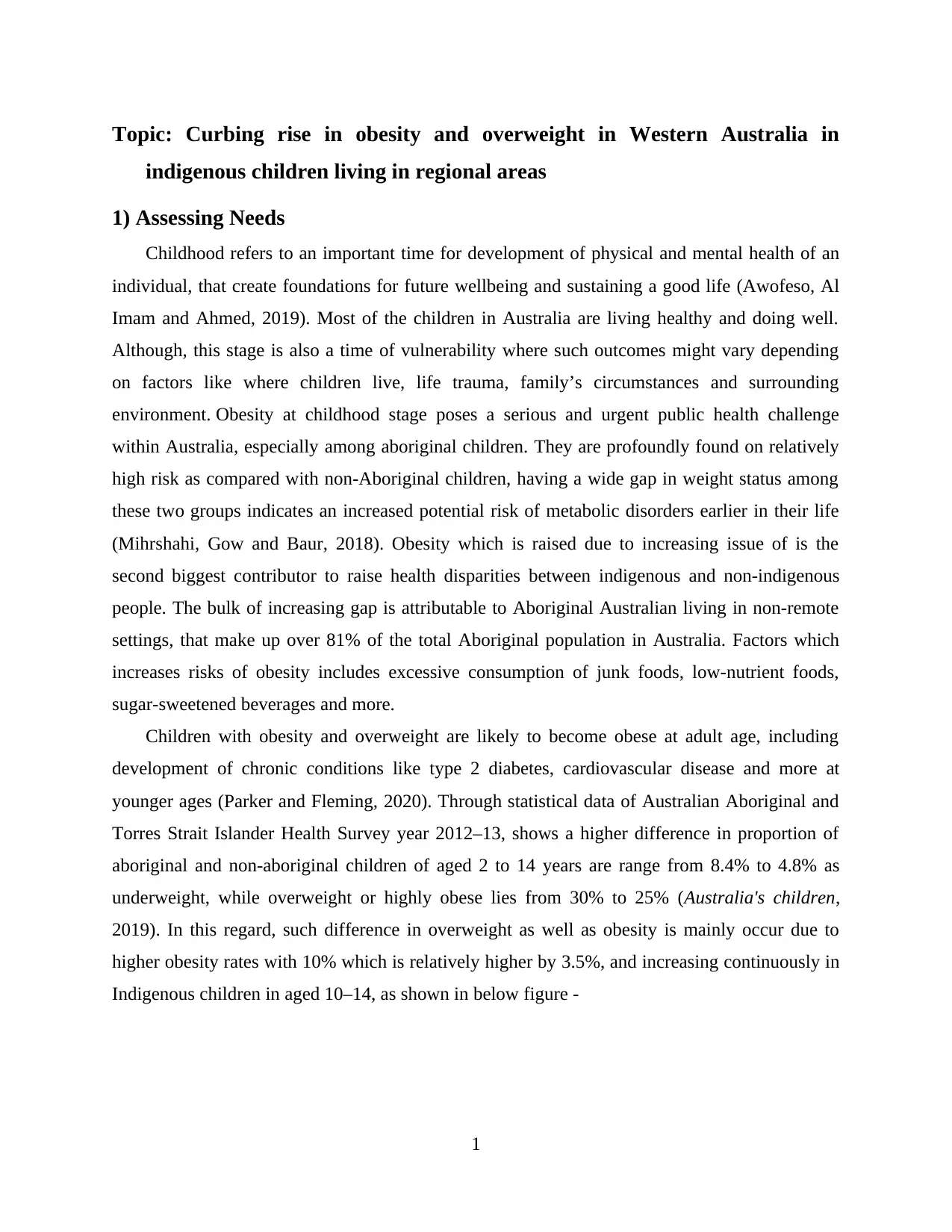
Topic: Curbing rise in obesity and overweight in Western Australia in
indigenous children living in regional areas
1) Assessing Needs
Childhood refers to an important time for development of physical and mental health of an
individual, that create foundations for future wellbeing and sustaining a good life (Awofeso, Al
Imam and Ahmed, 2019). Most of the children in Australia are living healthy and doing well.
Although, this stage is also a time of vulnerability where such outcomes might vary depending
on factors like where children live, life trauma, family’s circumstances and surrounding
environment. Obesity at childhood stage poses a serious and urgent public health challenge
within Australia, especially among aboriginal children. They are profoundly found on relatively
high risk as compared with non-Aboriginal children, having a wide gap in weight status among
these two groups indicates an increased potential risk of metabolic disorders earlier in their life
(Mihrshahi, Gow and Baur, 2018). Obesity which is raised due to increasing issue of is the
second biggest contributor to raise health disparities between indigenous and non-indigenous
people. The bulk of increasing gap is attributable to Aboriginal Australian living in non-remote
settings, that make up over 81% of the total Aboriginal population in Australia. Factors which
increases risks of obesity includes excessive consumption of junk foods, low-nutrient foods,
sugar-sweetened beverages and more.
Children with obesity and overweight are likely to become obese at adult age, including
development of chronic conditions like type 2 diabetes, cardiovascular disease and more at
younger ages (Parker and Fleming, 2020). Through statistical data of Australian Aboriginal and
Torres Strait Islander Health Survey year 2012–13, shows a higher difference in proportion of
aboriginal and non-aboriginal children of aged 2 to 14 years are range from 8.4% to 4.8% as
underweight, while overweight or highly obese lies from 30% to 25% (Australia's children,
2019). In this regard, such difference in overweight as well as obesity is mainly occur due to
higher obesity rates with 10% which is relatively higher by 3.5%, and increasing continuously in
Indigenous children in aged 10–14, as shown in below figure -
1
indigenous children living in regional areas
1) Assessing Needs
Childhood refers to an important time for development of physical and mental health of an
individual, that create foundations for future wellbeing and sustaining a good life (Awofeso, Al
Imam and Ahmed, 2019). Most of the children in Australia are living healthy and doing well.
Although, this stage is also a time of vulnerability where such outcomes might vary depending
on factors like where children live, life trauma, family’s circumstances and surrounding
environment. Obesity at childhood stage poses a serious and urgent public health challenge
within Australia, especially among aboriginal children. They are profoundly found on relatively
high risk as compared with non-Aboriginal children, having a wide gap in weight status among
these two groups indicates an increased potential risk of metabolic disorders earlier in their life
(Mihrshahi, Gow and Baur, 2018). Obesity which is raised due to increasing issue of is the
second biggest contributor to raise health disparities between indigenous and non-indigenous
people. The bulk of increasing gap is attributable to Aboriginal Australian living in non-remote
settings, that make up over 81% of the total Aboriginal population in Australia. Factors which
increases risks of obesity includes excessive consumption of junk foods, low-nutrient foods,
sugar-sweetened beverages and more.
Children with obesity and overweight are likely to become obese at adult age, including
development of chronic conditions like type 2 diabetes, cardiovascular disease and more at
younger ages (Parker and Fleming, 2020). Through statistical data of Australian Aboriginal and
Torres Strait Islander Health Survey year 2012–13, shows a higher difference in proportion of
aboriginal and non-aboriginal children of aged 2 to 14 years are range from 8.4% to 4.8% as
underweight, while overweight or highly obese lies from 30% to 25% (Australia's children,
2019). In this regard, such difference in overweight as well as obesity is mainly occur due to
higher obesity rates with 10% which is relatively higher by 3.5%, and increasing continuously in
Indigenous children in aged 10–14, as shown in below figure -
1
Paraphrase This Document
Need a fresh take? Get an instant paraphrase of this document with our AI Paraphraser
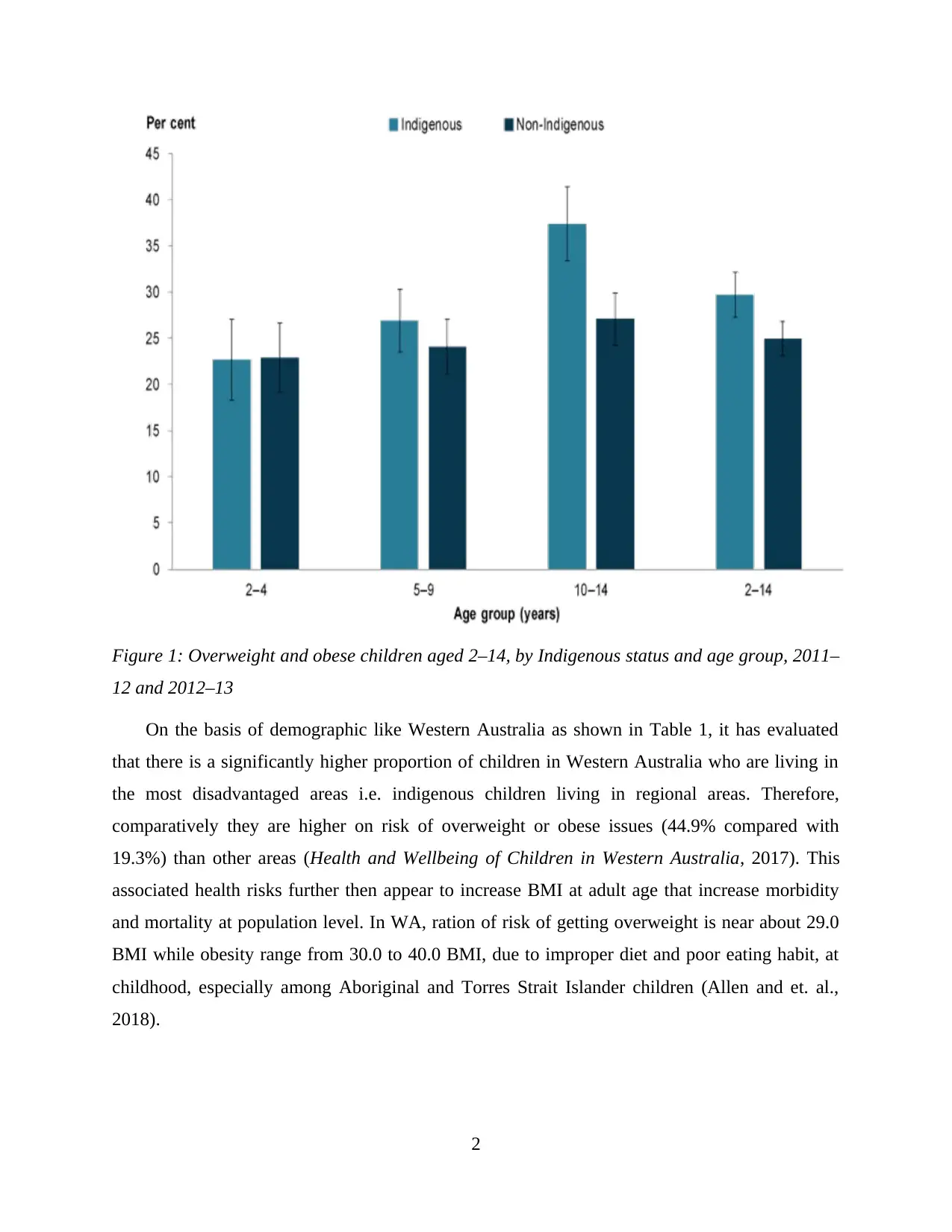
Figure 1: Overweight and obese children aged 2–14, by Indigenous status and age group, 2011–
12 and 2012–13
On the basis of demographic like Western Australia as shown in Table 1, it has evaluated
that there is a significantly higher proportion of children in Western Australia who are living in
the most disadvantaged areas i.e. indigenous children living in regional areas. Therefore,
comparatively they are higher on risk of overweight or obese issues (44.9% compared with
19.3%) than other areas (Health and Wellbeing of Children in Western Australia, 2017). This
associated health risks further then appear to increase BMI at adult age that increase morbidity
and mortality at population level. In WA, ration of risk of getting overweight is near about 29.0
BMI while obesity range from 30.0 to 40.0 BMI, due to improper diet and poor eating habit, at
childhood, especially among Aboriginal and Torres Strait Islander children (Allen and et. al.,
2018).
2
12 and 2012–13
On the basis of demographic like Western Australia as shown in Table 1, it has evaluated
that there is a significantly higher proportion of children in Western Australia who are living in
the most disadvantaged areas i.e. indigenous children living in regional areas. Therefore,
comparatively they are higher on risk of overweight or obese issues (44.9% compared with
19.3%) than other areas (Health and Wellbeing of Children in Western Australia, 2017). This
associated health risks further then appear to increase BMI at adult age that increase morbidity
and mortality at population level. In WA, ration of risk of getting overweight is near about 29.0
BMI while obesity range from 30.0 to 40.0 BMI, due to improper diet and poor eating habit, at
childhood, especially among Aboriginal and Torres Strait Islander children (Allen and et. al.,
2018).
2

Table 1: Prevalence of children by body mass index categories, 5 to 15 years
2) Program Overview and Setting the Goal
The complex nature of obesity and overweight both influenced highly by interplay between
a biological and genetic characteristic of an individual, including lifestyle factors’ impact such as
poor nutritional food, consumption of junk food and more. As Aboriginal Australians and
children living of Western Australia (WA), are relatively on higher risk of obesity and
overweight issues (Liamputtong, 2019). Therefore, it indicates requirement of a comprehensive
and multifaceted approach for target improvements to reduce its prevalence. In addition to this, a
strong advocacy voice is required to realise the key actions that are needed for curbing the rates
of overweight and obesity among indigenous children of WA living in regional areas (Farrell,
2018). For this purpose, interventions are needed to be taken, based on strategic goal – “To
prevent and improve obesity or overweight related risk behaviours among children of 0-10 years
from Indigenous families or socio-economically disadvantaged”.
3
2) Program Overview and Setting the Goal
The complex nature of obesity and overweight both influenced highly by interplay between
a biological and genetic characteristic of an individual, including lifestyle factors’ impact such as
poor nutritional food, consumption of junk food and more. As Aboriginal Australians and
children living of Western Australia (WA), are relatively on higher risk of obesity and
overweight issues (Liamputtong, 2019). Therefore, it indicates requirement of a comprehensive
and multifaceted approach for target improvements to reduce its prevalence. In addition to this, a
strong advocacy voice is required to realise the key actions that are needed for curbing the rates
of overweight and obesity among indigenous children of WA living in regional areas (Farrell,
2018). For this purpose, interventions are needed to be taken, based on strategic goal – “To
prevent and improve obesity or overweight related risk behaviours among children of 0-10 years
from Indigenous families or socio-economically disadvantaged”.
3
⊘ This is a preview!⊘
Do you want full access?
Subscribe today to unlock all pages.

Trusted by 1+ million students worldwide
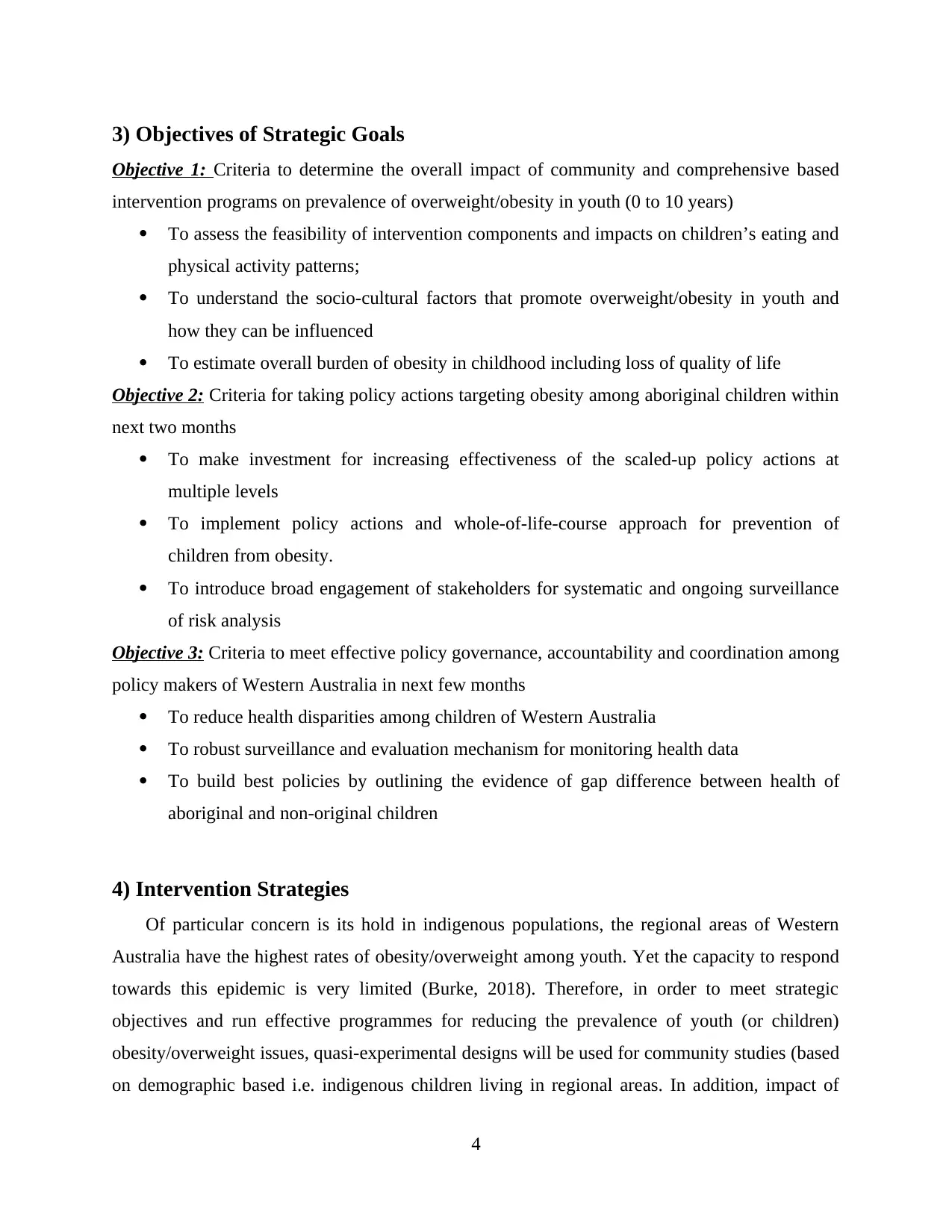
3) Objectives of Strategic Goals
Objective 1: Criteria to determine the overall impact of community and comprehensive based
intervention programs on prevalence of overweight/obesity in youth (0 to 10 years)
To assess the feasibility of intervention components and impacts on children’s eating and
physical activity patterns;
To understand the socio-cultural factors that promote overweight/obesity in youth and
how they can be influenced
To estimate overall burden of obesity in childhood including loss of quality of life
Objective 2: Criteria for taking policy actions targeting obesity among aboriginal children within
next two months
To make investment for increasing effectiveness of the scaled-up policy actions at
multiple levels
To implement policy actions and whole-of-life-course approach for prevention of
children from obesity.
To introduce broad engagement of stakeholders for systematic and ongoing surveillance
of risk analysis
Objective 3: Criteria to meet effective policy governance, accountability and coordination among
policy makers of Western Australia in next few months
To reduce health disparities among children of Western Australia
To robust surveillance and evaluation mechanism for monitoring health data
To build best policies by outlining the evidence of gap difference between health of
aboriginal and non-original children
4) Intervention Strategies
Of particular concern is its hold in indigenous populations, the regional areas of Western
Australia have the highest rates of obesity/overweight among youth. Yet the capacity to respond
towards this epidemic is very limited (Burke, 2018). Therefore, in order to meet strategic
objectives and run effective programmes for reducing the prevalence of youth (or children)
obesity/overweight issues, quasi-experimental designs will be used for community studies (based
on demographic based i.e. indigenous children living in regional areas. In addition, impact of
4
Objective 1: Criteria to determine the overall impact of community and comprehensive based
intervention programs on prevalence of overweight/obesity in youth (0 to 10 years)
To assess the feasibility of intervention components and impacts on children’s eating and
physical activity patterns;
To understand the socio-cultural factors that promote overweight/obesity in youth and
how they can be influenced
To estimate overall burden of obesity in childhood including loss of quality of life
Objective 2: Criteria for taking policy actions targeting obesity among aboriginal children within
next two months
To make investment for increasing effectiveness of the scaled-up policy actions at
multiple levels
To implement policy actions and whole-of-life-course approach for prevention of
children from obesity.
To introduce broad engagement of stakeholders for systematic and ongoing surveillance
of risk analysis
Objective 3: Criteria to meet effective policy governance, accountability and coordination among
policy makers of Western Australia in next few months
To reduce health disparities among children of Western Australia
To robust surveillance and evaluation mechanism for monitoring health data
To build best policies by outlining the evidence of gap difference between health of
aboriginal and non-original children
4) Intervention Strategies
Of particular concern is its hold in indigenous populations, the regional areas of Western
Australia have the highest rates of obesity/overweight among youth. Yet the capacity to respond
towards this epidemic is very limited (Burke, 2018). Therefore, in order to meet strategic
objectives and run effective programmes for reducing the prevalence of youth (or children)
obesity/overweight issues, quasi-experimental designs will be used for community studies (based
on demographic based i.e. indigenous children living in regional areas. In addition, impact of
4
Paraphrase This Document
Need a fresh take? Get an instant paraphrase of this document with our AI Paraphraser
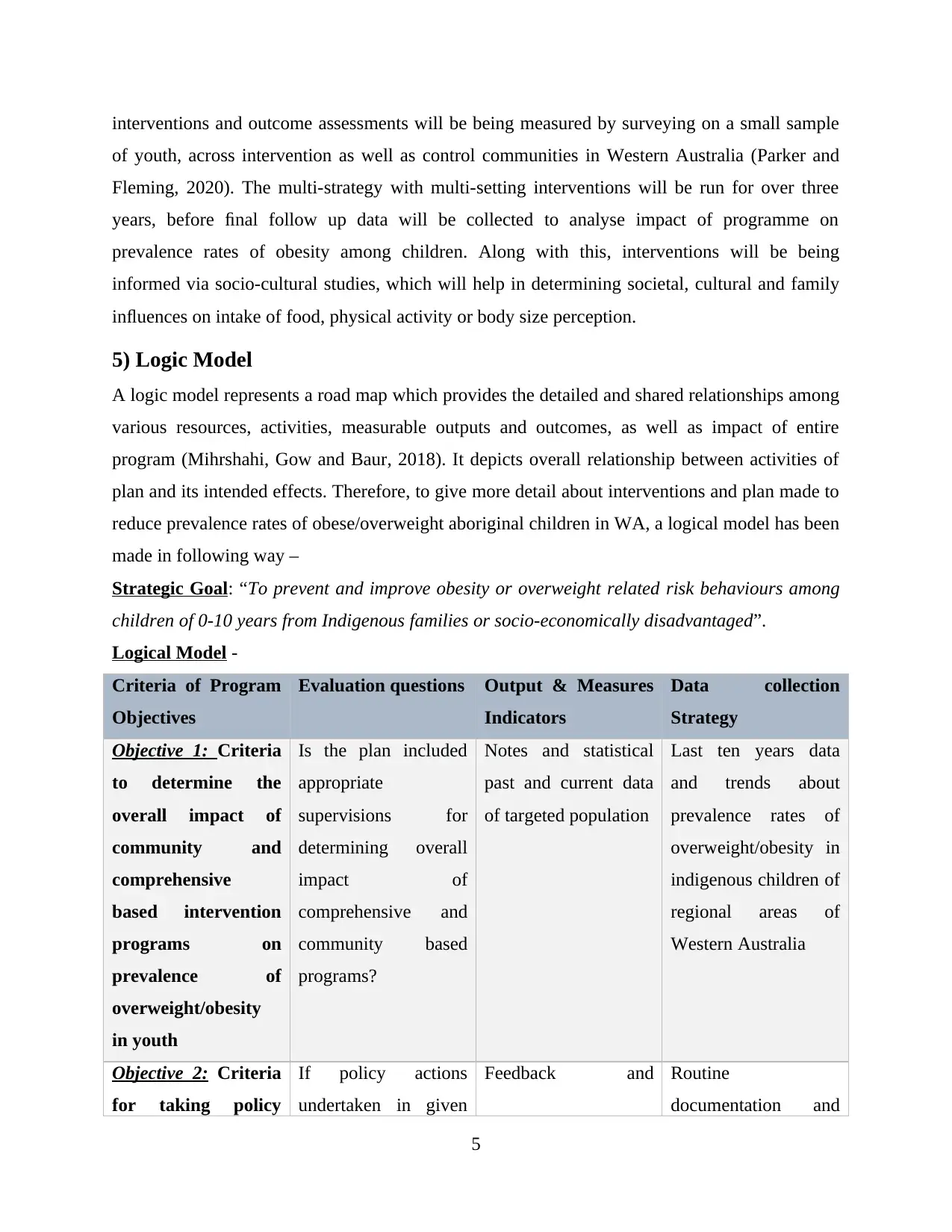
interventions and outcome assessments will be being measured by surveying on a small sample
of youth, across intervention as well as control communities in Western Australia (Parker and
Fleming, 2020). The multi-strategy with multi-setting interventions will be run for over three
years, before final follow up data will be collected to analyse impact of programme on
prevalence rates of obesity among children. Along with this, interventions will be being
informed via socio-cultural studies, which will help in determining societal, cultural and family
influences on intake of food, physical activity or body size perception.
5) Logic Model
A logic model represents a road map which provides the detailed and shared relationships among
various resources, activities, measurable outputs and outcomes, as well as impact of entire
program (Mihrshahi, Gow and Baur, 2018). It depicts overall relationship between activities of
plan and its intended effects. Therefore, to give more detail about interventions and plan made to
reduce prevalence rates of obese/overweight aboriginal children in WA, a logical model has been
made in following way –
Strategic Goal: “To prevent and improve obesity or overweight related risk behaviours among
children of 0-10 years from Indigenous families or socio-economically disadvantaged”.
Logical Model -
Criteria of Program
Objectives
Evaluation questions Output & Measures
Indicators
Data collection
Strategy
Objective 1: Criteria
to determine the
overall impact of
community and
comprehensive
based intervention
programs on
prevalence of
overweight/obesity
in youth
Is the plan included
appropriate
supervisions for
determining overall
impact of
comprehensive and
community based
programs?
Notes and statistical
past and current data
of targeted population
Last ten years data
and trends about
prevalence rates of
overweight/obesity in
indigenous children of
regional areas of
Western Australia
Objective 2: Criteria
for taking policy
If policy actions
undertaken in given
Feedback and Routine
documentation and
5
of youth, across intervention as well as control communities in Western Australia (Parker and
Fleming, 2020). The multi-strategy with multi-setting interventions will be run for over three
years, before final follow up data will be collected to analyse impact of programme on
prevalence rates of obesity among children. Along with this, interventions will be being
informed via socio-cultural studies, which will help in determining societal, cultural and family
influences on intake of food, physical activity or body size perception.
5) Logic Model
A logic model represents a road map which provides the detailed and shared relationships among
various resources, activities, measurable outputs and outcomes, as well as impact of entire
program (Mihrshahi, Gow and Baur, 2018). It depicts overall relationship between activities of
plan and its intended effects. Therefore, to give more detail about interventions and plan made to
reduce prevalence rates of obese/overweight aboriginal children in WA, a logical model has been
made in following way –
Strategic Goal: “To prevent and improve obesity or overweight related risk behaviours among
children of 0-10 years from Indigenous families or socio-economically disadvantaged”.
Logical Model -
Criteria of Program
Objectives
Evaluation questions Output & Measures
Indicators
Data collection
Strategy
Objective 1: Criteria
to determine the
overall impact of
community and
comprehensive
based intervention
programs on
prevalence of
overweight/obesity
in youth
Is the plan included
appropriate
supervisions for
determining overall
impact of
comprehensive and
community based
programs?
Notes and statistical
past and current data
of targeted population
Last ten years data
and trends about
prevalence rates of
overweight/obesity in
indigenous children of
regional areas of
Western Australia
Objective 2: Criteria
for taking policy
If policy actions
undertaken in given
Feedback and Routine
documentation and
5
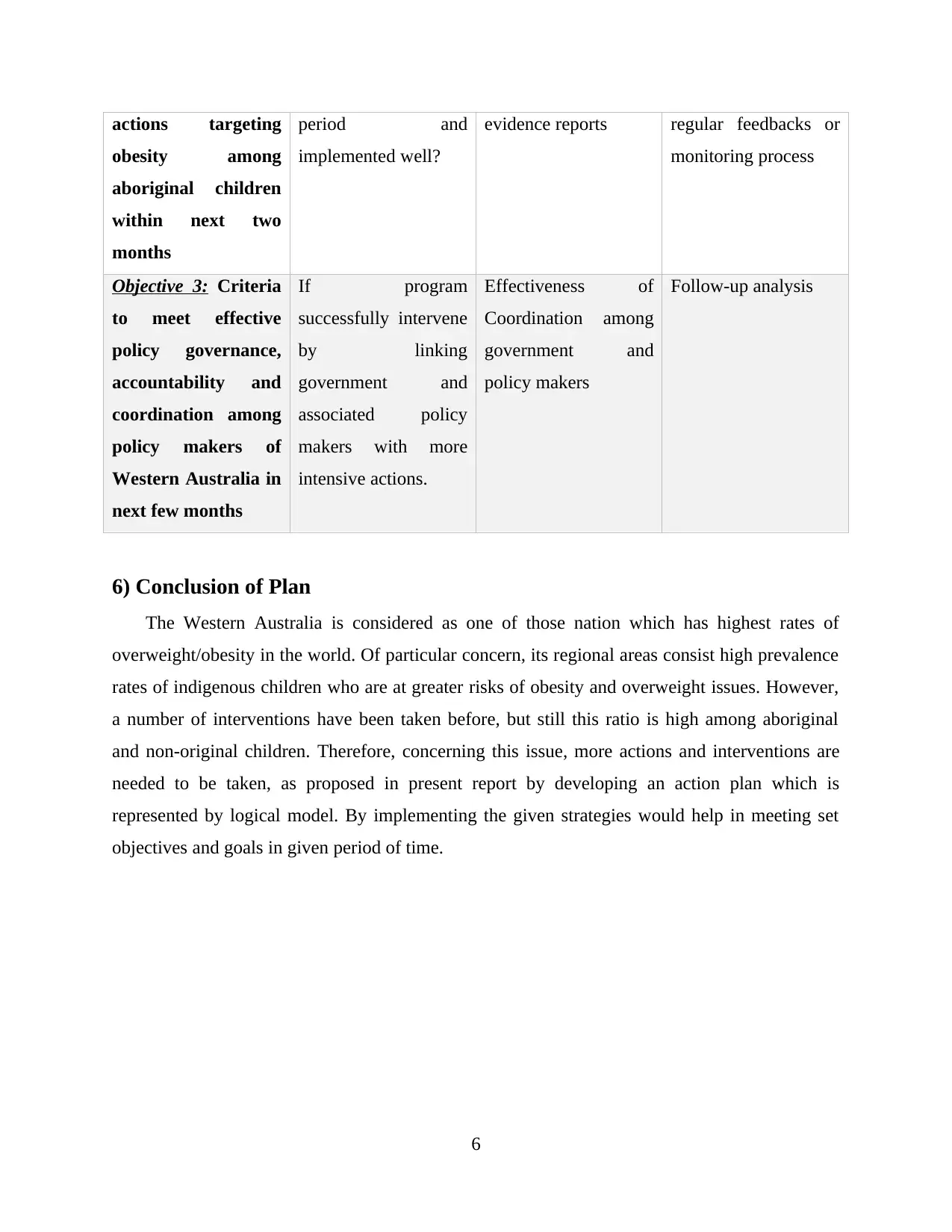
actions targeting
obesity among
aboriginal children
within next two
months
period and
implemented well?
evidence reports regular feedbacks or
monitoring process
Objective 3: Criteria
to meet effective
policy governance,
accountability and
coordination among
policy makers of
Western Australia in
next few months
If program
successfully intervene
by linking
government and
associated policy
makers with more
intensive actions.
Effectiveness of
Coordination among
government and
policy makers
Follow-up analysis
6) Conclusion of Plan
The Western Australia is considered as one of those nation which has highest rates of
overweight/obesity in the world. Of particular concern, its regional areas consist high prevalence
rates of indigenous children who are at greater risks of obesity and overweight issues. However,
a number of interventions have been taken before, but still this ratio is high among aboriginal
and non-original children. Therefore, concerning this issue, more actions and interventions are
needed to be taken, as proposed in present report by developing an action plan which is
represented by logical model. By implementing the given strategies would help in meeting set
objectives and goals in given period of time.
6
obesity among
aboriginal children
within next two
months
period and
implemented well?
evidence reports regular feedbacks or
monitoring process
Objective 3: Criteria
to meet effective
policy governance,
accountability and
coordination among
policy makers of
Western Australia in
next few months
If program
successfully intervene
by linking
government and
associated policy
makers with more
intensive actions.
Effectiveness of
Coordination among
government and
policy makers
Follow-up analysis
6) Conclusion of Plan
The Western Australia is considered as one of those nation which has highest rates of
overweight/obesity in the world. Of particular concern, its regional areas consist high prevalence
rates of indigenous children who are at greater risks of obesity and overweight issues. However,
a number of interventions have been taken before, but still this ratio is high among aboriginal
and non-original children. Therefore, concerning this issue, more actions and interventions are
needed to be taken, as proposed in present report by developing an action plan which is
represented by logical model. By implementing the given strategies would help in meeting set
objectives and goals in given period of time.
6
⊘ This is a preview!⊘
Do you want full access?
Subscribe today to unlock all pages.

Trusted by 1+ million students worldwide

References
Books and Journals
Allen, J. M. & et. al. (2018). Raising levels of school student engagement and retention in rural,
regional and disadvantaged areas: is it a lost cause?. International Journal of Inclusive
Education. 22(4). 409-425.
Awofeso, N., Al Imam, S., & Ahmed, A. (2019). Content analysis of media coverage of
childhood obesity topics in UAE newspapers and popular social media platforms, 2014-
2017. International Journal of Health Policy and Management. 8(2). 81.
Burke, P. (2018). An Australian Indigenous diaspora: Warlpiri matriarchs and the refashioning
of tradition. Berghahn Books.
Farrell, A. (2018). Children’s Rights to Healthy Development and Learning in Quality Early
Childhood Education and Care in Australia. In Positive Schooling and Child
Development (pp. 383-398). Springer, Singapore.
Liamputtong, P. (Ed.). (2019). Public health: local and global perspectives. Cambridge
University Press.
Mihrshahi, S., Gow, M. L., & Baur, L. A. (2018). Contemporary approaches to the prevention
and management of paediatric obesity: an Australian focus. Medical Journal of
Australia, 209(6), 267-274.
Parker, E., & Fleming, M. L. (2020). Health Promotion: Principles and practice in the
Australian context. Routledge.
Online
Australia's children. (2019). [Online] Available Through:<
https://www.aihw.gov.au/reports/children-youth/australias-children/contents/health/
overweight-and-obesity >.
Health and Wellbeing of Children in Western Australia. (2017). [Online] Available Through:<
https://ww2.health.wa.gov.au/~/media/Files/Corporate/Reports%20and
%20publications/Population%20surveys/Health-and-Wellbeing-of-Children-in-Western-
Australia-2017.pdf >.
7
Books and Journals
Allen, J. M. & et. al. (2018). Raising levels of school student engagement and retention in rural,
regional and disadvantaged areas: is it a lost cause?. International Journal of Inclusive
Education. 22(4). 409-425.
Awofeso, N., Al Imam, S., & Ahmed, A. (2019). Content analysis of media coverage of
childhood obesity topics in UAE newspapers and popular social media platforms, 2014-
2017. International Journal of Health Policy and Management. 8(2). 81.
Burke, P. (2018). An Australian Indigenous diaspora: Warlpiri matriarchs and the refashioning
of tradition. Berghahn Books.
Farrell, A. (2018). Children’s Rights to Healthy Development and Learning in Quality Early
Childhood Education and Care in Australia. In Positive Schooling and Child
Development (pp. 383-398). Springer, Singapore.
Liamputtong, P. (Ed.). (2019). Public health: local and global perspectives. Cambridge
University Press.
Mihrshahi, S., Gow, M. L., & Baur, L. A. (2018). Contemporary approaches to the prevention
and management of paediatric obesity: an Australian focus. Medical Journal of
Australia, 209(6), 267-274.
Parker, E., & Fleming, M. L. (2020). Health Promotion: Principles and practice in the
Australian context. Routledge.
Online
Australia's children. (2019). [Online] Available Through:<
https://www.aihw.gov.au/reports/children-youth/australias-children/contents/health/
overweight-and-obesity >.
Health and Wellbeing of Children in Western Australia. (2017). [Online] Available Through:<
https://ww2.health.wa.gov.au/~/media/Files/Corporate/Reports%20and
%20publications/Population%20surveys/Health-and-Wellbeing-of-Children-in-Western-
Australia-2017.pdf >.
7
1 out of 10
Related Documents
Your All-in-One AI-Powered Toolkit for Academic Success.
+13062052269
info@desklib.com
Available 24*7 on WhatsApp / Email
![[object Object]](/_next/static/media/star-bottom.7253800d.svg)
Unlock your academic potential
Copyright © 2020–2025 A2Z Services. All Rights Reserved. Developed and managed by ZUCOL.





